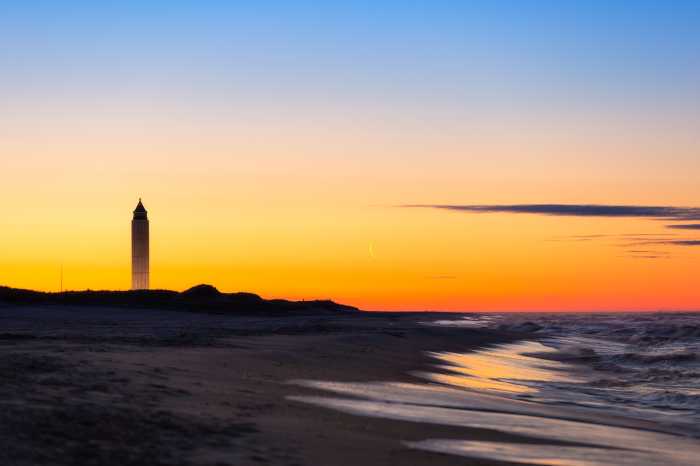 Offshore wind turbines would rise 30 miles south of far western Fire Island under a plan approved by New York Governor Andrew Cuomo on July 18, 2019.What has been named the Empire Wind Project would mainly be off Nassau County – at its closest point 14 miles south of Jones Beach – and then extend in a block in the ocean to the southeast. It will be this southeast portion that would be 30 miles south of the western end of Fire Island.The Empire Wind Project would consist of 88 wind turbines if 10-megawatt turbines are used. It would be constructed by a Norwegian company called Equinor. The Empire Wind Project was one of two proposed offshore wind farms Cuomo announced he had given his okay to. The second would start 30 miles east of Montauk Point and, also if 10-megawatt turbines are used, would have 82 wind turbines. It is being called the Sunrise Wind Project.Gordian Raacke, executive director of Renewable Energy Long Island – which has long urged the use of offshore wind – commented on Cuomo’s announcement: “We are witnessing a tipping point in energy history and today’s commitment to largescale investment in offshore wind power proves that New York walks the walk of powering our economy with renewable energy.”“Offshore Wind Farms Are Spinning Up In The US – At Last,” headlined Wired magazine in April. Its article noted that “wind power is nothing new in this country” and 56,000 wind turbines are in operation on land. “But wind farms located offshore, where wind blows steady and strong, unobstructed by buildings or mountains, have yet to start cranking.” That is now changing. A factor in that is “the technology needed to install them farther away from shore has improved … making them more palatable to nearby communities.”Economics favors wind energy. Wired noted that the Massachusetts Department of Public Utilities, who in April awarded Vineyard Wind a contract to provide electricity from offshore wind turbines “at 8.9 cents per kilowatt-hour.” The average price of electricity per kilowatt-hour in the U.S. is currently more than 12 cents per kilowatt-hour.The wind and the sun don’t send bills. Once wind turbines are erected, or solar panels installed, there’s no charge for fuel: energy blows in the wind and shines down from the sun freely.Still, said Wired, developers of offshore wind need to “respond to concerns about potential harm to fisheries and marine life.”Fishing interests, and others have raised this issue within the Town of East Hampton, where a 15-turbine wind farm, also east of Montauk Point, has been proposed. (It’s not part of the projects just given the state okay.) In East Hampton, too, the group Win With Wind has formed and maintains that offshore wind and fishing can be compatible. Leading figures in Win With Wind are former East Hampton Town Supervisors Judith Hope and Larry Cantwell, both with exemplary environmental records.Offshore wind power has been booming outside the U.S. for years. Indeed, Denmark-based Orsted, involved in the Sunrise Wind Project Cuomo approved off Montauk Point, operates 1,150 offshore wind turbines off Denmark, the United Kingdom, Germany, Taiwan and Holland.“We’ve built more offshore wind farms than any other developer in the world and we’ve only begun,” Orsted says on its website. “The Orsted vision is a world that runs entirely on green energy.”Orsted purchased Deepwater Wind, a Rhode Island-based company, last year and then entered into a partnership on several wind projects with Eversource, the largest energy supplier in New England. Orsted and Eversource are partners in the two wind farms proposed off Montauk Point.Meanwhile, Equinor says on its website: “Equinor is building a material position in renewable energy, in particular in offshore wind. We are involved in a number of significant wind projects worldwide, including four in the UK, one in Germany, and one in the U.S.,” referring to the Empire Wind Project.The first offshore wind farm to rise in U.S. waters was developed by Deepwater Wind. It began running off Block Island in 2016. It’s now operated by Orsted.I’ve been to the five-turbine Block Island wind farm. Each turbine occupies a small footprint in the ocean. Their 240-foot long blades revolve slowly, silently, indeed gracefully. “Awesome!” said one passenger on the boatload of officials and environmentalists. “Beautiful,” said another.At a beach on Block Island there are cable connections, but you could not notice them. They run underground. Their only sign is a conventional manhole cover used for maintenance located in the parking lot of the public beach. Another concern expressed by some in East Hampton has involved the location of wind farm cables onto shore.Cuomo not only approved the two offshore wind power projects on July 18, but also signed the Climate Leadership and Community Protection Act passed by the state legislature in June. The act’s provisions include requiring New York to achieve a carbon- free electricity system by 2040.A contradiction to the state’s approach is Cuomo having in recent years pushed a $7.6 bailout of four uneconomic upstate nuclear power plants. It is adding a surcharge on the electric bills of every individual ratepayer, business, educational and governmental entity in the state. It is predicated on the false claim that nuclear power doesn’t emit carbon-based greenhouse gases when, in fact, the “nuclear cycle” including mining, milling and fuel enrichment is carbon intensive and nuclear plants themselves have emissions including radioactive carbon.Cuomo in his remarks on July 18 also said: “The environment and climate change are the most critically important policy priorities we face. They literally determine the future – or the lack thereof. Even in today’s chaos of political pandering and hyperbole there are still facts, data and evidence – and climate change is an undeniable fact. But cries for a new green movement are hollow political rhetoric if not combined with aggressive goals and a realistic plan on how to achieve them.” With the agreement on the two wind farms and his signing of “the most aggressive climate law in the United States of America … today we are true to the New York legacy – to lead the way forward, to govern with vision and intelligence, to set a new standard, and to match our words with action.”Sitting alongside Cuomo was former Vice President Al Gore who commented that “our transition away from the dirty and polluting ways of the past is absolutely essential to our survival and for reasons well known to all of us here, it’s not being led at the federal level at all. But thank goodness it is being led by New York State and others that have joined with the leadership of Governor Cuomo.”
Offshore wind turbines would rise 30 miles south of far western Fire Island under a plan approved by New York Governor Andrew Cuomo on July 18, 2019.What has been named the Empire Wind Project would mainly be off Nassau County – at its closest point 14 miles south of Jones Beach – and then extend in a block in the ocean to the southeast. It will be this southeast portion that would be 30 miles south of the western end of Fire Island.The Empire Wind Project would consist of 88 wind turbines if 10-megawatt turbines are used. It would be constructed by a Norwegian company called Equinor. The Empire Wind Project was one of two proposed offshore wind farms Cuomo announced he had given his okay to. The second would start 30 miles east of Montauk Point and, also if 10-megawatt turbines are used, would have 82 wind turbines. It is being called the Sunrise Wind Project.Gordian Raacke, executive director of Renewable Energy Long Island – which has long urged the use of offshore wind – commented on Cuomo’s announcement: “We are witnessing a tipping point in energy history and today’s commitment to largescale investment in offshore wind power proves that New York walks the walk of powering our economy with renewable energy.”“Offshore Wind Farms Are Spinning Up In The US – At Last,” headlined Wired magazine in April. Its article noted that “wind power is nothing new in this country” and 56,000 wind turbines are in operation on land. “But wind farms located offshore, where wind blows steady and strong, unobstructed by buildings or mountains, have yet to start cranking.” That is now changing. A factor in that is “the technology needed to install them farther away from shore has improved … making them more palatable to nearby communities.”Economics favors wind energy. Wired noted that the Massachusetts Department of Public Utilities, who in April awarded Vineyard Wind a contract to provide electricity from offshore wind turbines “at 8.9 cents per kilowatt-hour.” The average price of electricity per kilowatt-hour in the U.S. is currently more than 12 cents per kilowatt-hour.The wind and the sun don’t send bills. Once wind turbines are erected, or solar panels installed, there’s no charge for fuel: energy blows in the wind and shines down from the sun freely.Still, said Wired, developers of offshore wind need to “respond to concerns about potential harm to fisheries and marine life.”Fishing interests, and others have raised this issue within the Town of East Hampton, where a 15-turbine wind farm, also east of Montauk Point, has been proposed. (It’s not part of the projects just given the state okay.) In East Hampton, too, the group Win With Wind has formed and maintains that offshore wind and fishing can be compatible. Leading figures in Win With Wind are former East Hampton Town Supervisors Judith Hope and Larry Cantwell, both with exemplary environmental records.Offshore wind power has been booming outside the U.S. for years. Indeed, Denmark-based Orsted, involved in the Sunrise Wind Project Cuomo approved off Montauk Point, operates 1,150 offshore wind turbines off Denmark, the United Kingdom, Germany, Taiwan and Holland.“We’ve built more offshore wind farms than any other developer in the world and we’ve only begun,” Orsted says on its website. “The Orsted vision is a world that runs entirely on green energy.”Orsted purchased Deepwater Wind, a Rhode Island-based company, last year and then entered into a partnership on several wind projects with Eversource, the largest energy supplier in New England. Orsted and Eversource are partners in the two wind farms proposed off Montauk Point.Meanwhile, Equinor says on its website: “Equinor is building a material position in renewable energy, in particular in offshore wind. We are involved in a number of significant wind projects worldwide, including four in the UK, one in Germany, and one in the U.S.,” referring to the Empire Wind Project.The first offshore wind farm to rise in U.S. waters was developed by Deepwater Wind. It began running off Block Island in 2016. It’s now operated by Orsted.I’ve been to the five-turbine Block Island wind farm. Each turbine occupies a small footprint in the ocean. Their 240-foot long blades revolve slowly, silently, indeed gracefully. “Awesome!” said one passenger on the boatload of officials and environmentalists. “Beautiful,” said another.At a beach on Block Island there are cable connections, but you could not notice them. They run underground. Their only sign is a conventional manhole cover used for maintenance located in the parking lot of the public beach. Another concern expressed by some in East Hampton has involved the location of wind farm cables onto shore.Cuomo not only approved the two offshore wind power projects on July 18, but also signed the Climate Leadership and Community Protection Act passed by the state legislature in June. The act’s provisions include requiring New York to achieve a carbon- free electricity system by 2040.A contradiction to the state’s approach is Cuomo having in recent years pushed a $7.6 bailout of four uneconomic upstate nuclear power plants. It is adding a surcharge on the electric bills of every individual ratepayer, business, educational and governmental entity in the state. It is predicated on the false claim that nuclear power doesn’t emit carbon-based greenhouse gases when, in fact, the “nuclear cycle” including mining, milling and fuel enrichment is carbon intensive and nuclear plants themselves have emissions including radioactive carbon.Cuomo in his remarks on July 18 also said: “The environment and climate change are the most critically important policy priorities we face. They literally determine the future – or the lack thereof. Even in today’s chaos of political pandering and hyperbole there are still facts, data and evidence – and climate change is an undeniable fact. But cries for a new green movement are hollow political rhetoric if not combined with aggressive goals and a realistic plan on how to achieve them.” With the agreement on the two wind farms and his signing of “the most aggressive climate law in the United States of America … today we are true to the New York legacy – to lead the way forward, to govern with vision and intelligence, to set a new standard, and to match our words with action.”Sitting alongside Cuomo was former Vice President Al Gore who commented that “our transition away from the dirty and polluting ways of the past is absolutely essential to our survival and for reasons well known to all of us here, it’s not being led at the federal level at all. But thank goodness it is being led by New York State and others that have joined with the leadership of Governor Cuomo.”




























